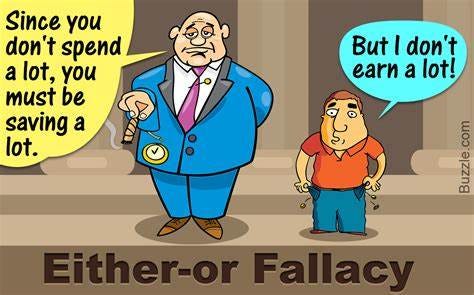Either/OR fallacy
🧠 Psych - 116 / 200
Hello hello!
Last letter of this month. Hope you had a fun September :)
Let’s learn about the “Either/OR” Fallacy.
What is it?
A person tries to argue that the solution to a problem can be only one of two alternatives, one which the claimant heavily favors and excluding an answer that may account for both options, or answers based on third options not discussed.
Examples -
Where does it occur?
When accidental, the either-or fallacy occurs just because we tend to skip a possible approach or option. However, when intentional, it’s especially meant to force a choice; it is used as an effective tool in advertising, media, and politics, in order to impose a thought or notion in people’s minds. [2]
Why do I need to know?
If you’re presented with an “either/or” dilemma, consider whether or not the two options presented to you are truly your only choices. Will refusing one option make the other one true by default?
If someone else is talking to you, think about the speaker’s motive and point of view. Are they trying to talk you into doing something by using a fear tactic by presenting the “alternative” option? If you do go along with what the other person is clearly presenting as the better option, who does that ultimately benefit–you, or them?
If you find that it is, in fact, a false dilemma, point that out to them by stating a third option. [1]
References & Studies: -
https://www.developgoodhabits.com/either-or-fallacy/#How_to_Respond_to_a_False_Dilemma_Fallacy
https://psychologenie.com/explanation-of-either-or-fallacy-with-examples
Looking for previous issues? Take a look at the Archives.
The Psych Handbook is your guide to learning biases in Psychology.


